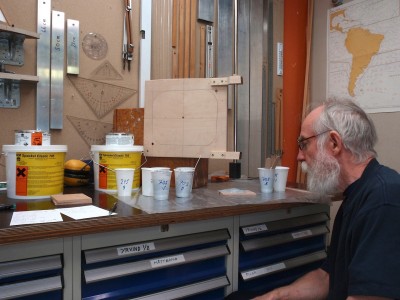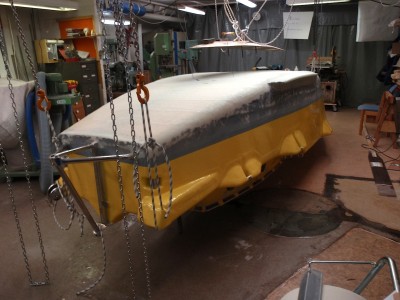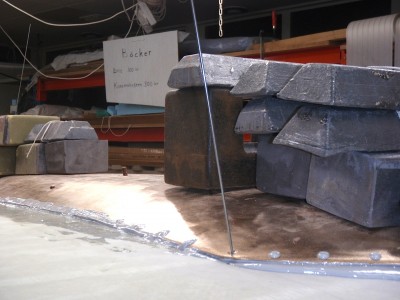To protect the boats bottom when taking the ground as the tide goes out and when dragging her up on a beach I have fitted a bronze shoe.
Bronze was chosen because it is easy cast, has good marine corrosion resistance is antifouling as it contains 90% cupper and is quite heavy thus also acts as good ballast.
It was cast for me by BLOMSTERMÅLA METALLGJUTERI.
Fastening it to the boat presented a challenge. Many boat builders use NM flexible epoxy 705 when attaching ballast keels to sail boat hulls as it is a high quality thixotropic flexible epoxy. What is not often recognised is that to press down the thixotropic requires quite a force if the surface is large. That’s no problem when you have plenty of strong keel bolts to tighten and a small surface. On mine boat it is the opposite a large area and only three 3/8 bronze bolts to the lightning conductor.
Each square centimetre required three kilos of pressure. With an area of almost one square meter or 100 by 100 centimetres I realised that I would need about 30 tons to squeeze out the epoxy, obviously not a practical proposition. After consulting the NM epoxy chemist it was decided that I should dilute the flexible epoxy with laminating epoxy to the desired degree. That would change the rheology to make the mixture more fluid but still flexible enough.
To find out the right mixture I built a crude apparatus and made some tests.
A piston with a certain area and weight was used attached to a rod which could slide up and down constrained by simple wooden bearings. After some testing I found a mixture of 55% flexible and 45% laminating epoxy was just about right.
First I was mixing the flexible resin and its hardener, and then mixing the laminating resin and its hardener, thirdly mixing the two mixtures together.
The job had to be done quickly because once the mixing was started there was pausing. I found six volunteers and ten a clock a Saturday morning we started.
Steel rods were in place to guide the bronze into the right position.
The mixture was spread out. The boat was lifted with chain hoists to take the weight of the bronze.
About 200 kilo of lead and cast iron weight was added to the 126 kilos of the bronze. The three bolts to the lightning conductor were tightened. The epoxy mixture flowed out nicely. The heat in the room was turned up to the maximum. The operation was successful. I thanked my volunteers they had done a good job, they were all needed. I slept well.




